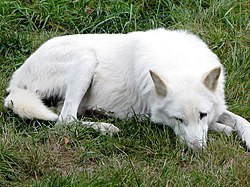Loup blanc (animal) — Wikipédia
Un loup blanc est un loup gris (Canis lupus) dont la robe est globalement blanche. Fréquent chez cette espèce, ce phénotype se retrouve chez les sous-espèces suivantes : le loup arctique[1], le loup de la Terre de Baffin[2], le loup d'Alaska[3], le loup de la toundra d'Alaska[4] et le loup de Terre-Neuve (aujourd'hui éteint)[2]. Cette couleur (en) est moins présente chez le loup de Vancouver et le dingo[5].
- Loup arctique (C. l. arctos)
- Loup de la Terre de Baffin (C. l. manningi)
- Dingo (C. l. dingo)
Articles connexes
[modifier | modifier le code]- Robe blanche du chien (couleur de robe du chien (de))
- Loup noir
- Loup rouge (C. l. rufus)
- Renard argenté
Références
[modifier | modifier le code]- ↑ (en) Juliet Clutton-Brock, Andrew C. Kitchener et John M. Lynch, « Changes in the skull morphology of the Arctic wolf, Canis lupus arctos, during the twentieth century », Journal of Zoology, Zoological Society of London, vol. 233, no 1, , p. 19-36 (DOI 10.1111/j.1469-7998.1994.tb05259.x, lire en ligne [PDF], consulté le ).
- (en) Stanley Paul Young et Edward Alphonso Goldman, The Wolves of North America, Part II: Classification of Wolves, Washington, Dover Publications, American Wind and Wildlife Institute (en), , 636 p..
- ↑ (en) Daniel Giraud Elliot, A check list of mammals of the North American continent, the West Indies and the neighboring seas, Chicago, musée Field, , 792 p. (lire en ligne).
- ↑ (en) Lucyan David Mech, The wolf: the ecology and behaviour of an endangered species, New York, University of Minnesota Press, musée américain d'histoire naturelle, , 384 p. (lire en ligne).
- ↑ (en) Mathew S. Crowther, Melanie Fillios, Nicholas J. Colman et Mike Letnic, « An updated description of the Australian dingo (Canis dingo Meyer, 1793) », Journal of Zoology, Zoological Society of London, vol. 293, no 3, , p. 192–203 (ISSN 0952-8369, DOI 10.1111/jzo.12134, lire en ligne [PDF], consulté le ).


 French
French Deutsch
Deutsch





